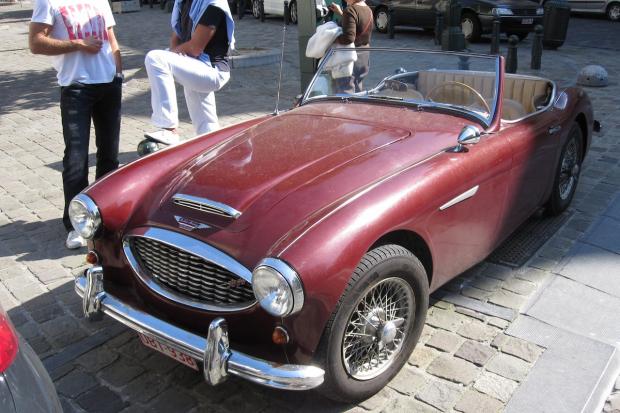
Visits to the Continent – especially ones made in fine weather – are often a highlight on the classic front as you drop into a capital and get surprised by the random sighting of old cars. Not that it doesn’t happen back in Blighty, mind, but it’s the unfamiliarity with the neighbourhood that somehow adds to the thrill.
While enjoying a cappuccino at a café on a square in Brussels last weekend, the hubbub from surrounding diners and background traffic was suddenly drowned out by the unmistakable creamy exhaust note of something boasting six-cylinders and, quite likely, British.
Moments later both predictions were proven when an Austin-Healey 3000 MkI nosed past, its owner looking for parking before he and his pretty partner headed off towards the Grand Place.
Now Big Healeys always get my attention because they’re close to my heart: we’ve had a 1957 100/6 in our family for the past 32 years and I even learned to drive in it!
To me a Healey is a car with a lot of soul, despite its foibles (scuttle shake, truck-like gearbox and heavy engine), which is why I’ve always appreciated examples that have been enjoyed; the old car world has too many boiled-sweet Healeys knocking around the club show circuit.

This 3000 Mk1 certainly appeared well used, with scruffy paint and the odd ding or two – plus home-made door cards – and the owner had no compunction in leaving it parked up on the square, either.
But it was the colour that really did it for me on the day – a burgundy metallic that’s not original but which took me straight back to the first time I discovered what an Austin-Healey looked like – in fact, what a classic car looked like. I was six years old and being ferried to school by my late father Peter when I asked him what his dream car was.
The words “Austin-Healey” that came in reply didn’t exactly fuel me with enthusiasm because I thought of Austin Apache (a South Africa-only derivative of the Austin 1100) and a lumbering Austin Westminster that I’d seen in my grandparent’s neighbourhood and which my parents had joked about as being an old folks’ car. But my dad directed me to a book called Cars in Retrospect to see what one looked like.
I can still recall coming home and diving into the bookcase in the lounge to find the book and there it was: a large double-page spread of a Healey 100/6 gleaming in deep burgundy with the paintwork offset by a desert background. I was captivated by the car’s lines and how sporting it looked; not remotely like the Austin Westminster or anything with an Austin name.
Fast-forward four years and my dad was finally in a position to fulfil his dream when a chance discussion at work led to the news of a Healey for sale: one of the circa 120 100/6s that were assembled from CKD kits in South Africa.
It wasn’t in good nick, mind: a previous owner had attempted a restoration in his garden with just a tarpaulin to protect it from the elements and, 10 years on, had lost the battle and sold it on. That was in 1977, meaning the work began in ‘67 when the Healey was just 10 years old.
Begs the thought as to what it must have looked like by then but it was academic: when my father looked at it was together but in a right mess and – as is inevitable – what started as a re-commissioning exercise quickly became close to a total restoration that swallowed up most of his evenings and weekends for the next 18 months.

Over the years the Healey (above) became part of the family, taking us on numerous Austin-Healey Club rallies – five up until one of us could be farmed out to someone with a spare seat! – while being used for special occasions – fetched on the last day of school and ferrying us to end-of-year dances.
Sadly the book that inspired my passion for classics seems to have long since been lost, but I guess my brothers Andrew, Kevin and I (who inherited it) are lucky enough to have the real thing and seeing that burgundy Healey burbling by took me right back to how it all began

